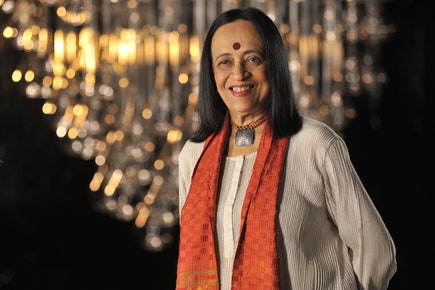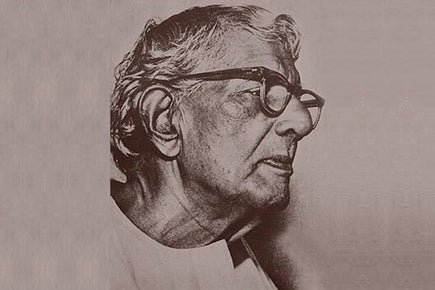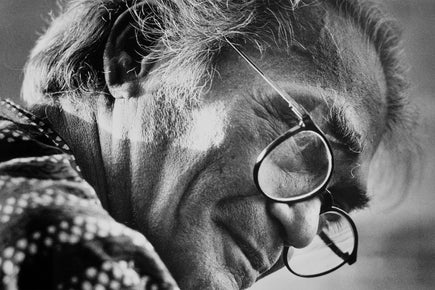Born Into Bollywood But Turned Photographer, Karan Kapoor Captures A Bygone Era
Far away from the arc lights, instead of basking in the glory of a rich cinematic lineage, Karan Kapoor, son of veteran actor Shashi Kapoor, and grandson of the stalwart Prithviraj Kapoor, was quietly preserving a piece of India’s history, with his camera lens.
 (Original portrait shot by Stuart McClymont; edited by Artisera)
(Original portrait shot by Stuart McClymont; edited by Artisera)
The enigmatic black and white pictures taken by Karan Kapoor between early 1980s to mid 1990s, delved into the identity of a fast disappearing Anglo-Indian community, and of a quiet and very different Goa to what we know today. “I knew I was capturing something that was going to go, something that was fading away,” reminisces the London based photographer, in our delightful phone conversation with him.
These soul-stirring images, part of a travelling exhibition organized by Tasveer titled ‘Time and Tide’, give us a glimpse into not just the communities he photographed, but the photographer himself, who is showing his personal works in India for the very first time with this exhibition.
 (Andheri, Bombay, 1981 - shot by Karan Kapoor; available for purchase on Artisera)
(Andheri, Bombay, 1981 - shot by Karan Kapoor; available for purchase on Artisera)
A Fraction of a Moment – The Journey Into Photography
Much before he became everyone’s “Dream Lover”, modelling in the famous Bombay Dyeing ads, Karan Kapoor was already on his destined path towards becoming an acclaimed and internationally awarded photographer. “I started taking photos during my school days in England, much before the modelling and films. I remember my parents gifted me this instamatic, and through most of my teen years, I used it to capture portraits,” says Karan Kapoor.
 (A print ad of Bombay Dyeing from Karan Kapoor's modelling days)
(A print ad of Bombay Dyeing from Karan Kapoor's modelling days)
When he returned to India after schooling, Karan Kapoor worked as filmmaker Govind Nihalani’s apprentice, and also spent time doing cinematography. “After working for some time behind the scenes in movies, I realized I preferred the spontaneous ‘fraction of a moment’ kind of pictures,” says Karan. “Also, the freedom of working for oneself, was something I yearned for.”
 (Exorcism, Goa, 1994 by Karan Kapoor, available for purchase on Artisera)
(Exorcism, Goa, 1994 by Karan Kapoor, available for purchase on Artisera)
He spent many hours in the studio and dark room of photographer and mentor Adrian Stevens, discussing cameras, photography and developing prints. But hailing from the family that he did, movies had to happen eventually. And so, Karan modelled and acted in a few Bollywood films in the 1970-80’s, but his soul wasn’t in it. In 1988, he decided to call it quits and moved to England, where his journey as a professional photographer, really began.
“I worked as a photojournalist for many years,” recalls Karan Kapoor. “Eventually, I became more focused on lifestyle and advertising photography; it became my way of documenting life, and it also paid much better.”
 (Karan Kapoor seated on his Royal Enfield; photo credit - Tanya Stagnetto)
(Karan Kapoor seated on his Royal Enfield; photo credit - Tanya Stagnetto)
The City of Joy
When he was in his late teens, Karan spent a lot of time in Calcutta (now Kolkata) with his Anglo-Indian girlfriend, who lived there. Through her, he got his first glimpse into the shrinking world of the Anglo-Indian community, to which he himself belonged. Later, during the shooting of the movie 36 Chowringhee Lane in Calcutta, the City of Joy, in which his mother Jennifer Kendal played an Anglo-Indian teacher, and in which he also had a minor role, Karan found himself deeply enamoured by the city and its Anglo-Indians.
 (Mr. Carpenter, Tollygunge, Calcutta, 1981 by Karan Kapoor; available for purchase on Artisera)
(Mr. Carpenter, Tollygunge, Calcutta, 1981 by Karan Kapoor; available for purchase on Artisera)
It was around this time that celebrated photographer Mary Ellen Mark, who was shooting Mother Teresa in Calcutta, gifted Karan a roll of film, a memory he remembers fondly.
“I used to record conversations with Anglo-Indian people so my mum could learn their accent and ways,” says Karan. “I spent time in their homes in Tollygunge and Park Circus talking to them, exploring their lives through photo albums, and taking their photographs.” It was the older generations that interested Karan the photographer, as these people knew what India was like pre-independence. “Everyone around them, the younger generation, was leaving. One could sense their discomfort, that feeling of being left behind; they were the last remaining remnants of the British Raj,” recalls Karan.
 (Tollygunge, Calcutta #5, 1980 by Karan Kapoor; available for purchase on Artisera)
(Tollygunge, Calcutta #5, 1980 by Karan Kapoor; available for purchase on Artisera)
These emotions and the aura are strikingly evident in the intimate and honest photographs which Karan Kapoor took of the Anglo-Indian community in Kolkata, and later, in Bangalore, Ooty and Bombay, many of which find place in the ‘Time and Tide’ collection.
 (Daphne Sampson, winner of the 1956 Marilyn Monroe look-alike contest, Ooty,
(Daphne Sampson, winner of the 1956 Marilyn Monroe look-alike contest, Ooty,
1987 by Karan Kapoor; available for purchase on Artisera)
Up Close and Personal
“Sometimes, my celebrity status became a problem while taking photos in India,” says Karan. “However, in the case of the “Goan series”, it was very different. I had real, intimate relationships with most of my subjects. It was about knowing them, speaking to them and taking photos at the last moment.”
 (Blessing of the Corn, Old Goa, 1992 by Karan Kapoor; available for purchase on Artisera)
(Blessing of the Corn, Old Goa, 1992 by Karan Kapoor; available for purchase on Artisera)
He recalls with nostalgia the many holidays spent in Goa with his parents and siblings in a shack, with a heart on its roof. “I used to ride my Royal Enfield or cycle around the place,” says Karan. “The man in the photo, 'Father of The Bride', was my neigbhour in Goa. My family knew everyone in the neighborhood back then; we used to be part of weddings, festivities and the everyday together.”
 (Father of the Bride, Goa, 1995 by Karan Kapoor; available for purchase on Artisera)
(Father of the Bride, Goa, 1995 by Karan Kapoor; available for purchase on Artisera)
He rues what has become of Goa today, and reminisces the fishing villages of yesteryears. His photograph of the fishing boat being hauled in, is symbolic of what Goa was, back in the 1980’s. “I didn’t realize when I took that photo of the boat, that everything would change so quickly,” says Karan. “Today the village is gone, the fishermen have become shack owners and taxi drivers. Earlier their lives were hard and they were poor, but they had a certain independence and physicality.”
 (Baga Beach, Goa, 1983, by Karan Kapoor; available for purchase on Artisera)
(Baga Beach, Goa, 1983, by Karan Kapoor; available for purchase on Artisera)
It is this dignity and fading time that resounds in every one of Karan Kapoor’s photographs that form the ‘Time and Tide’ collection. As a viewer, it is easy to muse over and lose yourself in these images, that take you back to a simpler time, and yet, feel magically real even today, after three decades.


























































































